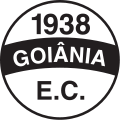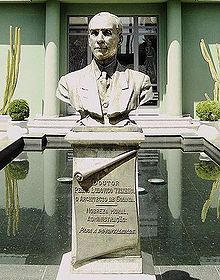Goiânia EC
| Goiânia EC | |||

|
|||
| Basic data | |||
|---|---|---|---|
| Surname | Goiânia Esporte Clube | ||
| Seat | Goiânia , Brazil | ||
| founding | July 5, 1938 | ||
| Website | goianiaesporteclube.com.br | ||
| First soccer team | |||
| Venue | Onésio Brasileiro Alvarenga | ||
| Places | 8,000 | ||
| league | Série C | ||
| 2002 | First round | ||
|
|
|||
The Goiânia Esporte Clube - usually just called Goiânia for short - is a football club from Goiânia , the capital of the Brazilian state of Goiás with around 1.2 million inhabitants . The club was launched on July 5, 1938, making it the second oldest football club in the city, which was only founded in 1933.
The club is often referred to as Galo after its mascot, a rooster, which is common in Brazil .
history
When the Campeonato Goiano, the state championship of Goiás , was held for the first time in 1944, Goiânia had to admit defeat to Atlético Goianiense , the state's oldest football club. Up to and including 1961, when Vila Nova , another club from Goiânia, was able to celebrate its first title, the two clubs made the title between themselves. The white-blacks, the Alvinegra , mostly kept the upper hand and won the state championship twelve times in those years, while Atlético's rivals were only able to collect four more titles in that era. Then Goiânia won the state competition also called Goianão only in 1968 and 1974. In 1967 they also won the regional tournament Copa Brasil Central before their traditional rivals Atlético Goianiense.
At the national level, Goiânia qualified four times between 1975 and 1979 for the games for the Brazilian Championship , which was introduced in 1971, but did not particularly stand out there. In 2000 Goiânia had the right to participate in the national championship competition advertised as Copa João Havelange , but in the end it was only classified as 99th in a field of 115 participants. The traditional club from Goiás felt the same when they took part in the national cup competition . In 1991 the end came in the first round, while in 2001 in the second round Corinthians from São Paulo was too high a hurdle. The rooster from Goiás achieved a respectable success in 1999 when he took part in the third highest national performance level, the Série C , when the traditional club Fluminense from Rio de Janeiro , which had hit rock bottom at the time , was defeated 4: 3 in the domestic Estádio Serra Dourada did not prevent the first round.
At the state level, Goiânia only managed three runners-up championships between 1975 and 1977 and two more in 1984 and 1990. Since the beginning of the 1990s, however, the club has been characterized by a persistent crisis. Participation in the first division of Goiás became the exception. In 1997 the club's now outdated Pedro Ludovico Teixeira stadium , once the largest in the state, fell to the wrecking ball.
From the end of the 1990s to the new millennium, the Alvinegra experienced a minor boom. But after the relegations to the second state league in 2003 and 2005 followed by the immediate resurgence, the club is now apparently established in the second division since relegation as the bottom of the table with only two wins from 17 games in 2007. The audience participation is also very low.
Stadion
Estádio Pedro Ludovico Teixeira
The club's own Estádio Pedro Ludovico , named after the founder of the city of Goiânia, was the largest stadium in the state when it opened in the 1960s, with a capacity of around 10,000. There is also a water sports center and a popular sports hall with a capacity of 5,000 on the stadium grounds.
The stadium itself gained national fame when it was used as a site for the contaminated and evacuated in the state's largest nuclear accident in 1987.
Twenty years after this event, the very outdated stadium was demolished. The completion of a new stadium on the site is not yet in sight.
Estádio Onésio Brasileiro Alvarenga
The stadium of local rivals Vila Nova FC , the Estádio Onésio Brasileiro Alvarenga , which is usually only called OBA for short, has also been Goiânia's home ground since then. The stadium in the city center has a capacity of around 8,000 spectators. It is named after Onésio Brasileiro Alvarenga, a former player and official who contributed significantly to the professionalization of Vila Nova.
Estádio Serra Dourada
The Estádio do Governo do Estado de Goiás , usually called Serra Dourada , is the largest stadium in Goiás and belongs to the state government. It was built until 1975 according to a plan by the architect Paulo Mendes da Rocha , who was later awarded the Pritzker Prize . Originally the stadium held around 80,000 spectators, but modernizations, increased comfort and more security have reduced the current capacity to 50,000.
The Goiânia EC uses the Serra Dourada ("Golden Mountains") whenever the expected audience response justifies it. Local competitors Goiás EC Vila Nova and Atlético Goianiense also use the stadium.
The Goiânia EC is also known as the "Curse of the Serra Dourada", because the club, once spoiled for success, has not won any titles since its opening.
The Serra Dourada is in the preselection for the Football World Cup 2014 .
Attendance records
- November 2, 1977 - 18,383 - 2: 6 vs. CR Vasco da Gama
- August 27, 1975 - 18,289 - 0-1 vs. SC Internacional (Porto Alegre)
- Sept. 12, 1976 - 17,792 - 2-4 vs. CR Vasco da Gama
- September 17, 1975 - 17,566 - 2-1 vs. CR Vasco da Gama
- August 11, 1975 - 16,914 - 1: 3 against Goiás EC
- All games in the Serra Dourada.
successes
- Men
-
 Goiás state championship : (14 x) 1945, 1946, 1948, 1950, 1951, 1952, 1953, 1954, 1956, 1958, 1959, 1960, 1968, 1974
Goiás state championship : (14 x) 1945, 1946, 1948, 1950, 1951, 1952, 1953, 1954, 1956, 1958, 1959, 1960, 1968, 1974
- Women
-
 Goiás State Championship : 2003
Goiás State Championship : 2003
Web links
Stadion:
